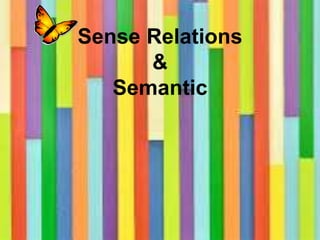
Sense relations & Semantics
- 2. The definition of Sense Relation. Sense relation is a paradigmatic relation between words or predicates. There are several kinds of sense relations as a result of the semantic relatedness between the form and meaning and between two meanings which will be discussed in the following.
- 3. 1. Synonymy Synonymy is the state or phenomenon in which the words that sound different (different in pronunciation) but have the same or identical meaning as another word or phrase. The concrete form of synonymy is called “synonymy”. Examples: Small = little Big = large Mother and father = parents Politician = statesman
- 4. 2. Polysemy Polysemy is the state or phenomenon in which the words that have more than one meaning. In other words, it can be described as multiple meanings of words. The words are considered to be related etymologically. The concrete form of polysemy is called “polyseme”. Examples: Plain Simple (English is extremely plain subject) With nothing added or not decorated in any way (this blouse is too plain).
- 5. 3. Hyponymy Hyponymy is the state or phenomenon that shows the relations between more general term (lexical representation) and the more specific instances of it. The concrete forms of sets of word (the specific instances) are called “hyponyms”. Example: The lexical representation of: red, yellow, green, purple, black, is color. Thus we can say that: “red is a hyponym of color”, and so on.
- 6. 4. Antonym Antonym is the state or phenomenon in which the words have the sense relation which involve the opposite of meaning. The concrete form of antonyms is called “antonym” (opposite).
- 8. Binary antonyms Binary antonyms come in pairs and between them exhausted all the relevant possibilities. If one is applicable, the other cannot be, and verse versa. Examples: true – false dead – alive married – unmarried same – different
- 9. Converse Conversances if a lexeme describes a relationship between two things (or people) and some other lexeme describes the same relationship when the two things are mentioned in the opposite order, then the two lexemes are CONVERSES of each other. Example: bellow – above love – hate conceal – reveal own – belong to
- 10. Gradable antonyms. • Two lexemes are gradable antonyms if they are at opposite ends of a continuous scale of values (a scale which typically varies according to the context of use). • Example: tall – short long – short clever – stupid top – bottom love – hate
- 11. Semantics Semantics is the study of meaning that is used to understand human expression through language. Semantics is perhaps the most difficult part of the grammar of a language to learn. The reason is because, basically, meanings in language are indefinite / undetermined. Remember that language is arbitrary (one of the characteristics of language). It is arbitrary because the relationship between forms and their meanings are sometimes cannot logically proved.
- 12. Classification of lexical meaning (1). Referential meaning (denotative meaning) – central meaning of words, stable, universal. Associative meaning – meaning that hinges on referential meaning, less stable, more culture- specific. Connotative meaning – the communicative value an expression has by virtue of what it refers to, embraces the properties of the referent, peripheral.
- 13. Classification of lexical meanings (2). Social meaning (stylistic meaning) – what is conveyed about the social circumstances of the use of a linguistic expression Affective meaning – what is communicated of the feeling or attitude of the speaker/writer towards what is referred to Reflected meaning – what is communicated through association with another sense of the same expression.
- 14. Classification of lexical meanings (3). Taboos Co locative meaning – the associated meaning a word acquires in line with the meaning of words which tend to co-occur with it.
- 15. Componential analysis. Componential analysis is the approach that analyzes word meaning by decomposing it into its atomic features. It shows the semantic features of a word. Examples: Man: +HUMAN +MALE +ADULT Boy: +HUMAN +MALE –ADULT Father: + HUMAN +MALE +ADULT →PARENT Daughter: +HUMAN –MALE +ADULT←PARENT
- 16. Words and concepts Categorization Categorization refers to the process by which people use language to classify the world around and inside them. It is fundamental to human cognition. In the past two decades cognitive psychologists and cognitive linguistics have gained new insights into the nature of categories. Prototypes A prototype is a set that has typical, central features. Others are peripheral features, which are not typical but related. Hierarchies. Conceptual network.
- 17. Metaphors Metaphors are well known as a stylistic feature of literature, but in fact are found in almost all language use, other than simple explanations of physical events in the material world. All abstract vocabulary is metaphorical, but in most cases the original language hides the metaphor from us. Depends means “hanging from” (in Latin), pornography means “writing of prostitutes” (in Greek) and even the hippopotamus has a metaphor in its name, which is Greek for “river horse”. A metaphor compares things, but does not show this with forms such as, like, or more [+qualifier] than. These appear in similes: fat as a pig, like two peas in a pod.
